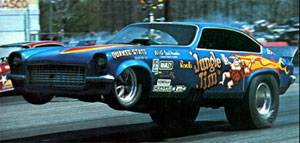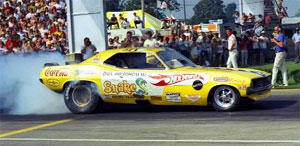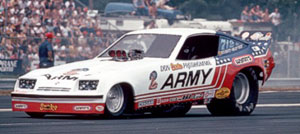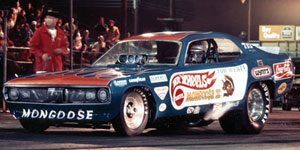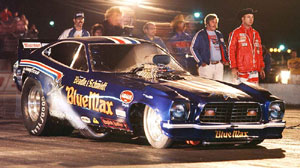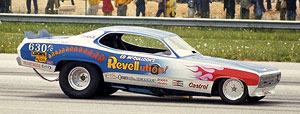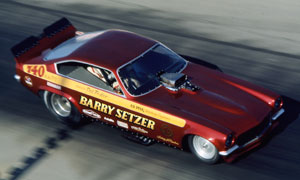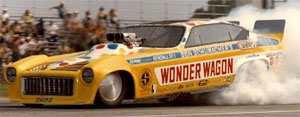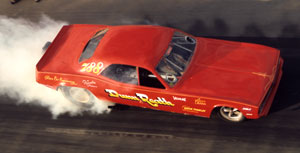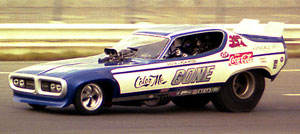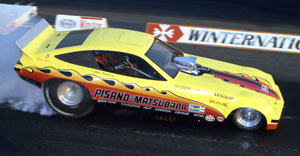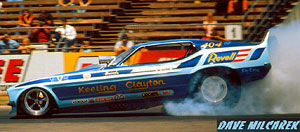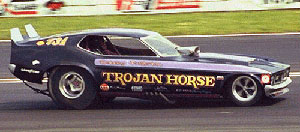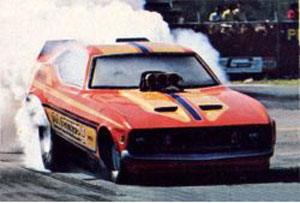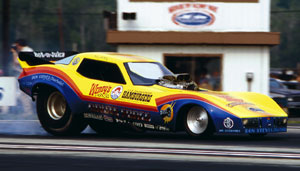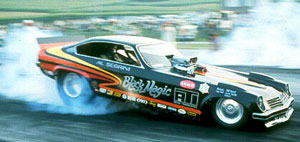

Favorite Race Car Ever voting: 1970s Funny Cars
| ||
| ||
| ||
| ||
| ||
| ||
| ||
| ||
| Final results for all-time favorite '70s Funny Car! | ||
| ŌĆ£Jungle JimŌĆØ Liberman Vega | 1033 | (27.03%) |
| Raymond Beadle Blue Max Mustang II | 741 | (19.39%) |
| Don Prudhomme Army Monza | 475 | (12.43%) |
| Don Prudhomme Hot Wheels ŌĆśCuda | 290 | (7.59%) |
| Barry Setzer/Pat Foster Vega | 277 | (7.25%) |
| John Force Wendy's Corvette | 175 | (4.58%) |
| Ed McCulloch Revellution Dodge | 157 | (4.11%) |
| Dunn & Reath Barracuda | 144 | (3.77%) |
| Roger Lindamood Color Me Gone | 124 | (3.24%) |
| Don Schumacher Wonder Wagon | 78 | (2.04%) |
| Tom McEwen Hot Wheels Duster | 77 | (2.01%) |
| Black Magic Vega | 75 | (1.96%) |
| Pisano & Matsubara Vega | 75 | (1.96%) |
| Larry Fullerton ŌĆś72 Trojan Horse | 49 | (1.23%) |
| Keeling & Clayton Mustang | 26 | (0.68%) |
| Condit Bros./Beaver L.A. Hooker | 26 | (0.68%) |
Total Votes: 3800 | ||
| ||
| ||
| ||
| ||
| ||
| ||
| ||
| ||
A lot of you have cried on my shoulder about earlier polls and the heart-wrenching decisions to have to select only one car out of many of your favorites listed, and this one wonŌĆÖt be any easier. As Steve Evans would have said, ŌĆ£ItŌĆÖs a fiberglass forest of all your favorites!ŌĆØ
The 1970s was a seminal time for Funny Cars. They had evolved from the somewhat crude machines of the 1960s and become a bigger draw than their dragster brethren, thanks to an assortment of body styles (that actually looked like their showroom counterparts), wild paint jobs, extreme showmanship, and wild antics. The people who drove them, too, seemed bigger than life, and their wild tales of caravanning across the nation and setting up shop sometimes three or four times a week at different tracks made them heroes to us all.
All right, time to spin ŌĆśem over. In no particular order other than how I wrote them down, here are the 16 qualifiers for the 1970s Funny Car poll in our Favorite Race Car Ever poll!
In the hearts of Funny Car fans everywhere, there probably is no greater personality than ŌĆ£Jungle JimŌĆØ Liberman. Say what you will about John Force ŌĆō and I love the man to death ŌĆō but ŌĆ£JungleŌĆØ was a one-off in so many ways, and his Vega Funny Car will live on in the memories of many as one of the real warhorses of the 1970s match-race scene. With fire burnouts, skillful and fearless driving, and cohort ŌĆ£Jungle PamŌĆÖsŌĆØ contribution to the act, itŌĆÖs no wonder he was and is a favorite.
ŌĆ£JungleŌĆÖsŌĆØ Chevy II won the Early Funny Cars portion of this deal and could double up here. Longtime JJ friend and historian ŌĆ£Berserko BobŌĆØ was surprised that I was surprised Liberman won the Early Funny Cars vote and pondered, ŌĆ£Can you imagine what JJ would be doing now if he was still around? His best friend was Austin Coil, and he had just signed a 7-Eleven deal that Vinnie Napp brokered for him. 1978 would have been ŌĆśJungle'sŌĆÖ year.ŌĆØ
I asked double B about the origin of the ŌĆ£JungleŌĆØ nickname, and his understanding is that it was given to him by the announcer at
Canadian fan Jim Millard remembers well his meeting with the Jungle duo at
While weŌĆÖre on the jungle theme, I might as well swing right into ŌĆ£the SnakeŌĆØ and ŌĆ£the Mongoose,ŌĆØ Don Prudhomme and Tom McEwen.
Prudhomme is the only racer with two cars in this poll ŌĆō he also had two cars each in the Early Dragsters and the 1970s Top Fuel polls but didnŌĆÖt come close to winning with any of them ŌĆō for a competition-high six entries, and IŌĆÖd say he has a good shot with both of these entries. The first car is his Hot Wheels Barracuda, which was his first flopper and debuted in 1970, and there were a couple of versions of it, including the mean-looking all-black Snake III that was runner-up at LionsŌĆÖ Last Drag Race.
Dale Smith, who today makes Satellite Funny Car bodies for the nostalgia scene, wrote, ŌĆ£You probably thought I would suggest a Satellite flopper as my favorite. Sorry, but I have to say that my all-time favorite car had to be ŌĆśSnakeŌĆÖsŌĆÖ black ŌĆśCuda. That thing was just bitchinŌĆÖ looking and eventually showed performance that I feel was better in its time compared to his
The second car, of course, is perhaps his most successful, the vaunted Army Monza from the 1975-76 seasons. As Smith noted, Prudhomme tried a trick-laden Vega in 1974 after the ŌĆśCuda, but it definitely was a flop. He sold it to Tom Hoover, then painted up the old ŌĆśCuda with the Army colors before getting the all-conquering
Wrote Paul Godfrey, ŌĆ£Prudhomme has always been one of my all-time heroes. His cars were all bad-ass, and he simply kicked ass on the track. HeŌĆÖs way cool, too! ŌĆśSnakeŌĆÖ has always had one of coolest logos ever ŌĆō even now.ŌĆØ
As cool as PrudhommeŌĆÖs coiled-snake logo is, McEwenŌĆÖs claws-out mongoose is pretty mean-looking, too, and ŌĆ£the ŌĆśGooseŌĆÖsŌĆØ Hot Wheels Dusters proved plenty capable of winning as well. The blue car at right carried him to
Speaking of blue, PrudhommeŌĆÖs run of four straight world championships was ended by Raymond Beadle and the Blue Max Mustang II in 1979, but Beadle and the Max already had become huge fan favorites long before then. His 1975 Indy final-round win over Prudhomme was just one of ŌĆ£SnakeŌĆÖsŌĆØ two losses that year, and Beadle was the second driver into the fives, in Indy in 1978.
Wrote Billy Mays, ŌĆ£My favorite is the Blue Max when it was tuned by ŌĆśWaterbed FredŌĆÖ [Miller]. You could be up in the grandstands listening to them start their engines in the pits, and you could always tell the Max because of its different sound.ŌĆØ
And, of course, no discussion about 1970s Funny Cars would be complete without Ed ŌĆ£the AceŌĆØ McCulloch, who not only barnstormed the country match racing like Liberman but also won a ton of NHRA national events between with his Revellution Dodges.
"I would drive all night and get to the next track just in time to unload the car and race," said McCulloch. "I loved it.ŌĆØ
McCullochŌĆÖs first win (of 22) came in Indy in 1971, where he won his first of six U.S. Nationals titles, but 1972 was definitely his finest year. He won the first three races of the year ŌĆō Winternationals, Gatornationals, and Springnationals ŌĆō before losing in the final of the Summernationals to Don Schumacher, then won the U.S. Nationals a second straight year. He just missed a third straight Indy win when he lost to Prudhomme in the final of the 1973 race and didnŌĆÖt win it again until 1980 with the Super Shops Arrow, but between the two, the line of Revellution cars more than kept alive the winning legacy. Mark Gredzinski called McCullochŌĆÖs cars ŌĆ£an example of the definitive ŌĆś70s Funny Car; his 1975/76 pinky-red Revellution Dart Sport: wicked stance from a Northwest Race Cars chassis, awesome lettering, etc.ŌĆØ
Wrote Oregonian Pete
The next car on the list drew about as many nominations as LibermanŌĆÖs Vega and is sure to do well. IŌĆÖm talking about the Pat Foster-driven Barry Setzer Vega ŌĆö truly one of the baddest Funny Cars in the land in 1972 and 1973, a national-record-setting event winner that was the definition of the over-used phrase ŌĆ£It looked as good as it ran.ŌĆØ
Readers used such terms as ŌĆ£drop-dead gorgeousŌĆØ and ŌĆ£quickest car of its dayŌĆØ and ŌĆ£awesome!ŌĆØ to describe the car driven by one of the most multitalented individuals in our sportŌĆÖs history.
Don Schumacher may be well-known for his four-car Funny Car operation today, but ŌĆ£the ShoeŌĆØ also was a great driver in his own right and a U.S. Nationals champ. His Stardust cars kicked some serious butt, but in 1973, he gained more ink for a car that wasnŌĆÖt so much a winner as it was innovative: the Wonder Wagon Vega. The car, backed by Interstate Bakeries, was colorful to say the least but also very functional, including a flow-through grille, fender bubble to lower the front end, enclosed side windows, louvered rear window, disc-covered wheels, and much more. It was low and sexy but not necessarily overly successful. The ŌĆÖ74 version was much better (the Vega then had the slant nose) and was runner-up to Prudhomme that year in
Another fan favorite, also more for its innovation than its on-track success, was Jim DunnŌĆÖs line of Plymouth-bodied Dunn & Reath Funny Cars, with the emphasis on his rear-engine Barracuda that to this day is still the only rear-engine Funny Car to win an NHRA national event, the 1972 Supernationals at Ontario Motor Speedway. A lot of guys ŌĆö including Force ŌĆö tried rear-engine Funny Cars, but few could make them work. Heath Powell hit it on the head when he called the car ŌĆ£a grand experiment that was a decent success.ŌĆØ
Steve Henshaw remembers DunnŌĆÖs first ŌĆśCuda well because he crewed on it. ŌĆ£It was built way under budget from the other cars at the time,ŌĆØ he recalled. ŌĆ£I can remember Jim saying to people that it only cost $3,000 to build the car. Everyone was running 426 Hemis, and we ran a 392 Hemi. The crew, Tim (ŌĆśthe WeedŌĆÖ), ŌĆśBig Richard,ŌĆÖ Marv (the clutch man), ŌĆśBig Jim,ŌĆÖ and many other no-name, just-fun guys, helped on the car. It was, at that time, direct drive; weŌĆÖd do burnouts and push it back to the line. It used to drive everyone nuts because our speed was always lower (shutting off at the first light), but ŌĆśBig JimŌĆÖ could cut a light. It was always funny because we would always pit out in the end with nobody around us. People were always thinking as if something was hidden in the car (ŌĆśWeedŌĆÖsŌĆÖ special fuel pump). I remember being at the Winternationals and pop-riveting pie pans to the aluminum over the slicks because the new slicks grew too high and having a blower explosion and using duct tape to put it back together. Today when watching on ESPN and seeing Mike Dunn and his dad on TV always sends me back to the days of the old black Ford pickup towing that old trailer and all the enjoyment of being around a great group of guys who truly loved drag racing. Those were the best days with the best cars and drivers ŌĆö no computers, just running with experience and a good ear to know that the car was right.ŌĆØ
If you followed the Coca-Cola Cavalcade of Stars series, then you knew the next car on the list, Roger LindamoodŌĆÖs Color Me Gone. Lindamood was another driver who followed the path from Super Stock to Funny Car, and his long line of Color Me Gone entries entertained fans through two decades. A former U.S. Nationals champ (1964, Top Stock), Lindamood gained a huge following in the late 1960s with his Dodge Charger-bodied machines and continued to run hard well into the 1970s.
For years, Joe Pisano and driver Sush Matsubara terrorized the West Coast match race scene with a series of Pisano & Matsubara entries that only got prettier, which became a Pisano trademark. Their ŌĆÖ73 and ŌĆÖ74 Vegas, and later their
Larry Fullerton loved his Fords, and a rare Maverick-bodied car preceded this purple-hued ŌĆś71 Mustang, but all his cars bore the Trojan Horse name, and all were great-looking cars. After stunning the crowd at the Summernationals with a 6.42, then the quickest pass ever by a fuel coupe,
The Keeling & Clayton team, whose pretty Top Fuelers were eye candy in every way, also put their California Charger stamp on a series of cars, including a Pinto and a Trans Am driven by the likes of Tom Ferraro, Neil Lefler, and Rick Ramsey, but itŌĆÖs their Jake Johnston-shoed Mustang that got nominated here.
SoCal fans also well-remember the L.A. Hooker line of cars, fielded by the Condit brothers, Steve and Dave, with Dave in the saddle, and their cousin Gene Beaver. When the team split up in the late 1970s, ŌĆ£Uncle Beavs,ŌĆØ as John Force calls him, got to keep the name ŌĆö reportedly inspired by and a response to the Chi-Town Hustler, but there are more X-rated versions of the story ŌĆö and continued to field the car, by then a Mustang II, with such drivers as Jim White and Dale Pulde.
Speaking of Force, one of his early cars made it here, the colorful WendyŌĆÖs Corvette that carried him to his first two of nine straight runner-ups, at the 1979 Cajun Nationals (to Kenny Bernstein) and 1979 Summernationals (to Raymond Beadle). It truly was the first of ForceŌĆÖs cars to match its contemporaries not only in appearance but in performance, though it would still be another eight years before his first win.
And, finally, comes the sleek and pretty Black Magic Vega, which Al Segrini shoed to victory at the 1974 Summernationals, beating ŌĆ£Jungle JimŌĆØ in the crazy final round in which ŌĆ£JungleŌĆØ carried the front end nearly the length of the track. Originally owned by Jim Beattie of ATI transmission fame, R.C. Sherman took over the wheel from 1976 to 1978, and D.A. Santucci drove it from then until well into the 1990s with Ford bodies.
Okay, there they are ŌĆ” 16 great contenders for your vote, every one of them memorable in its own way. Get to voting! Also, voting is still open in the Favorite ŌĆś70s Top Fueler poll; scroll down two columns to vote!
Thanks to Drag Racing Memories, Dave Milcarek, Larry Pfister, and Geoff Stunkard for the use of some of their photos.





















































